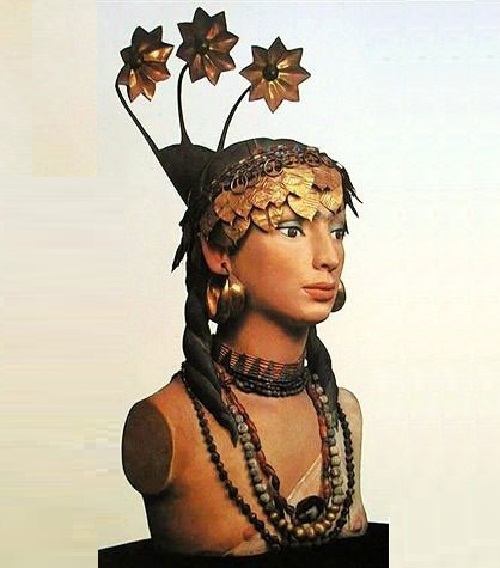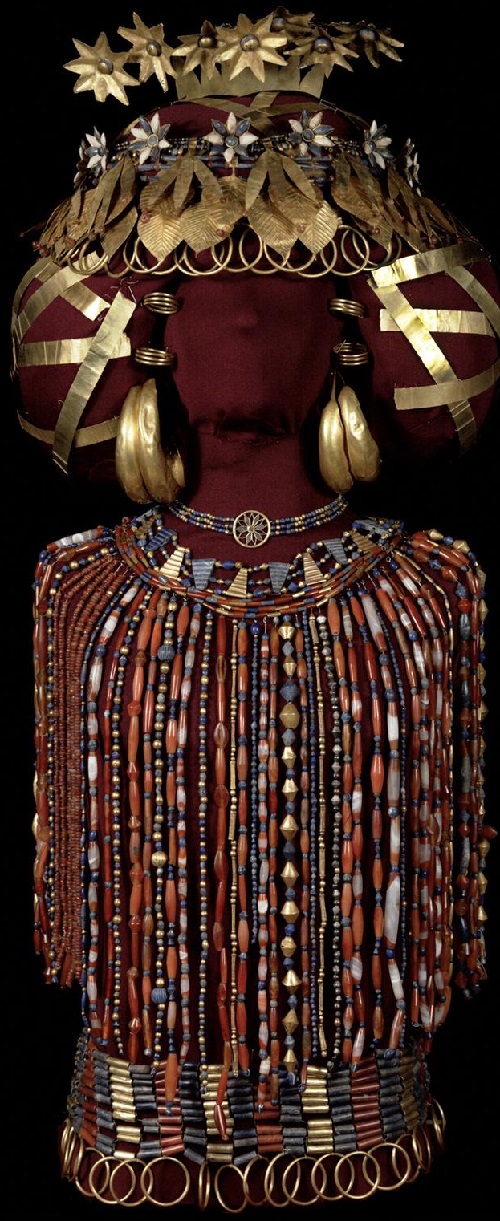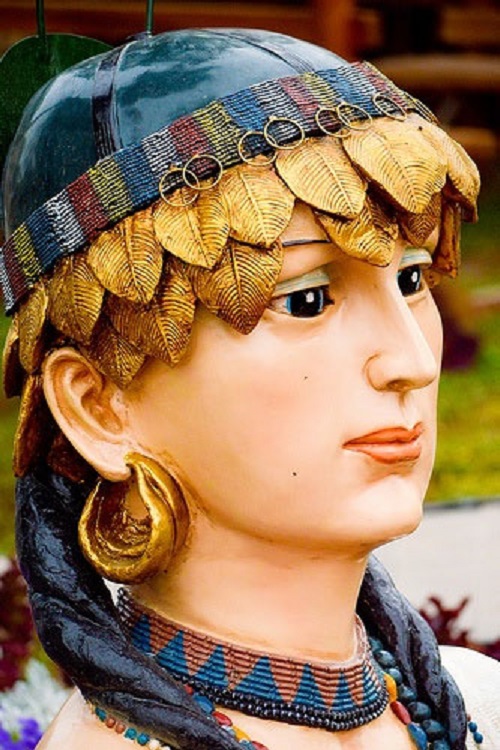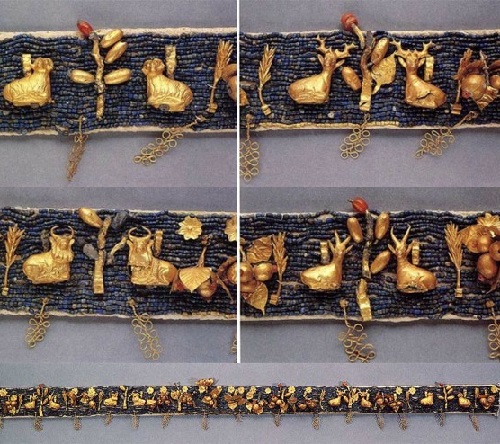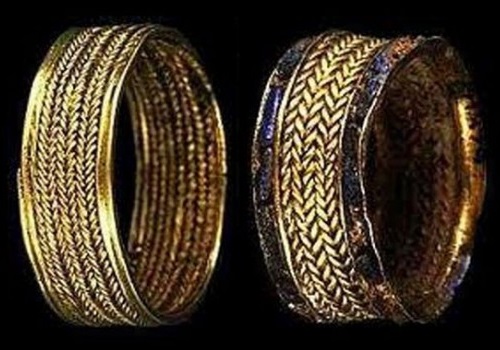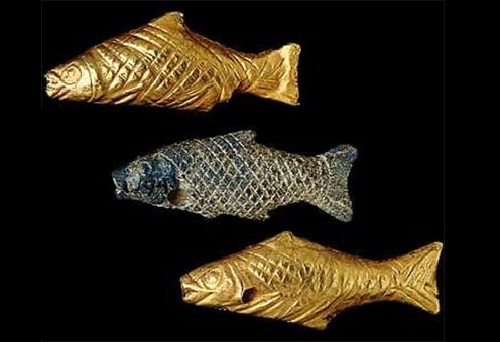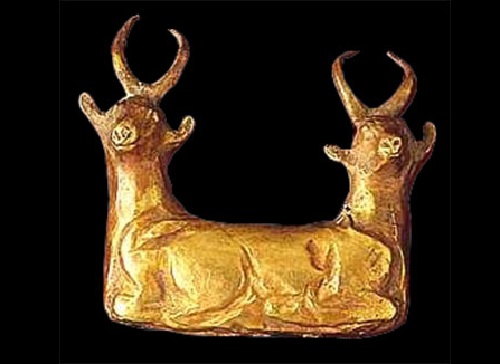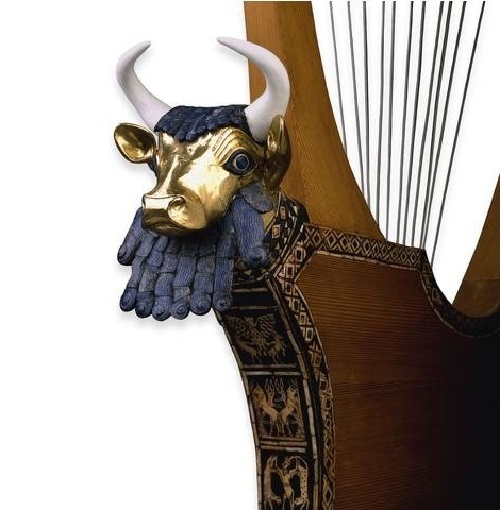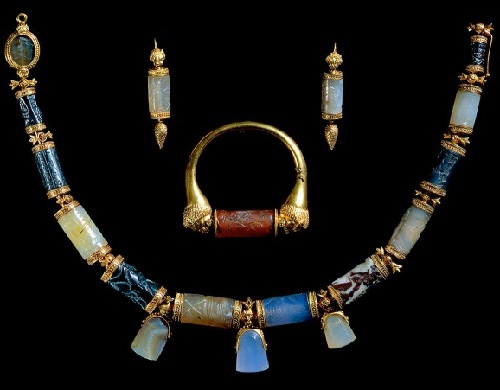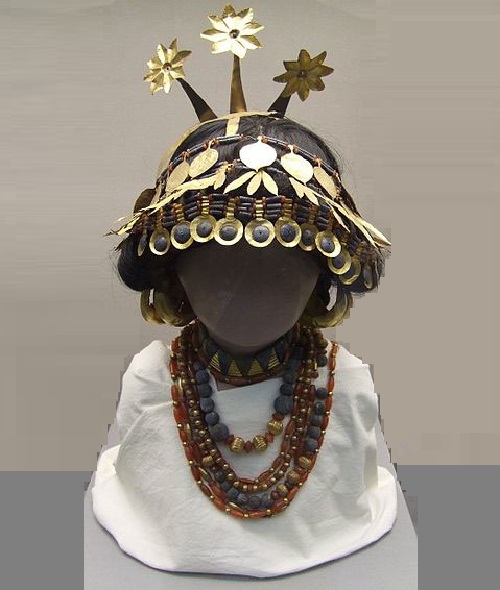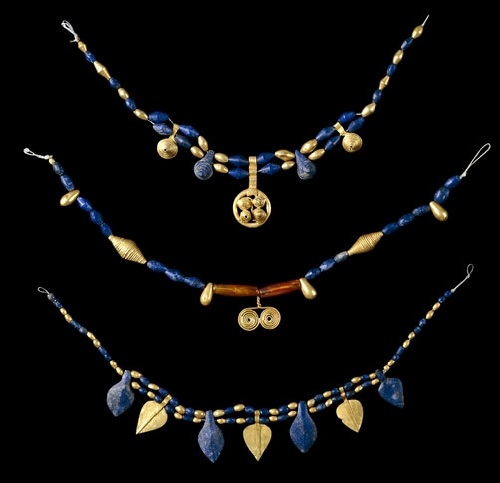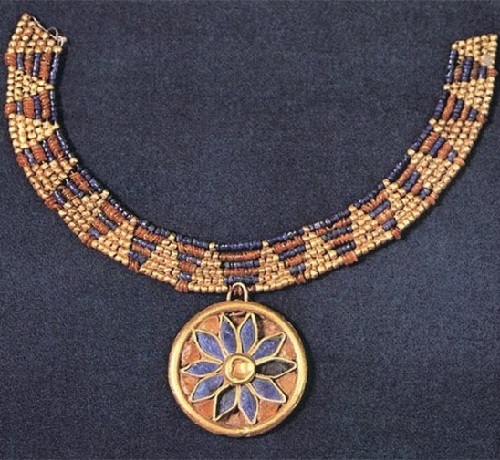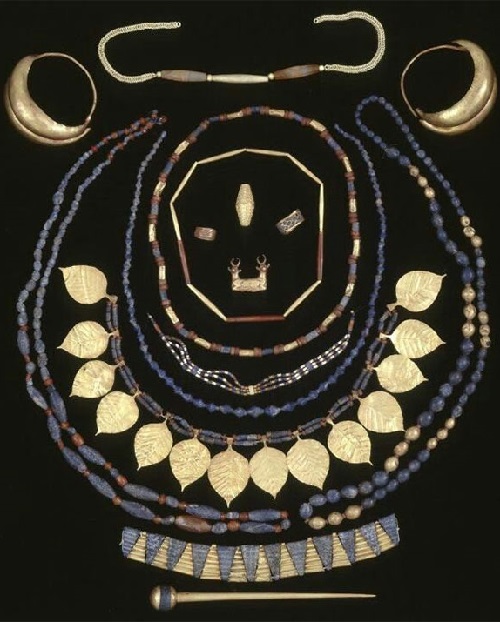Queen Puabi jewellery
Queen Puabi jewellery
It was an archaeologist Sir Charles Leonard Woolley, who opened Ancient Sumerian jewelry. He led excavations in the Sumerian city of Ur in the 1920s and found the tomb of Queen Puabi (Shubad), whose age is 4,5 thousand years. The treasures from the tomb of Puabi, which, like the tomb of Tutankhamun, did not suffer from the hands of the robbers, are now at the Pennsylvania University Museum and the British Museum. Unfortunately, the part that was at the Baghdad museum was looted during the war in 2003. The ancient Sumerian city of Ur was in present-day Iraq, between Baghdad and the Persian Gulf, close to the gulf.
Until now, there was debate – who this noble woman was, buried with honor? Often called the queen, she might have ruled Ur. According to another version, she was a priestess of Inanna – Goddess of Love, Wisdom, War, Fertility and Lust. Ancient Sumerians had practice to elect the king and his main task was to participate in the ritual, during which he became the husband of Inanna. So, the king took on the divine nature and immortality, not only for himself but also for his people.
Puabi was the epitome of Inanna – the main female deity for the Sumerians. The ritual took place during the celebration of the New Year (Spring) and lasted for several days. Inanna later reincarnated as the goddess Ishtar in ancient Babylon, the cult of Ishtar spread throughout the East: Ashtaret, Astarte, Tanit – are also her names. Ishtar was identified with the Egyptian Isis, in ancient times, it will be replaced with Venus and Aphrodite.
In one of the Sumerian myth “Inanna’s Descent to the Underworld” is said that the goddess had to go down to the realm of her sister Ereshkigal, the goddess of the dead. Inanna had to pass through seven gates, each time removing part of her royal robes and jewelry. After the last, 7th gate, she was completely naked and helpless, like a normal mortal, Ereshkigal turned her into a corpse.
When Inanna died, on the ground stopped life, stopped giving birth, love stopped, and the gods began to take measures to return Inanna. On the way back, with the returning of her jewelry, returned her force. This fragment of the myth shows that jewelry for Sumerian priestesses Puabi had much more significance and meaning than we are accustomed to think.
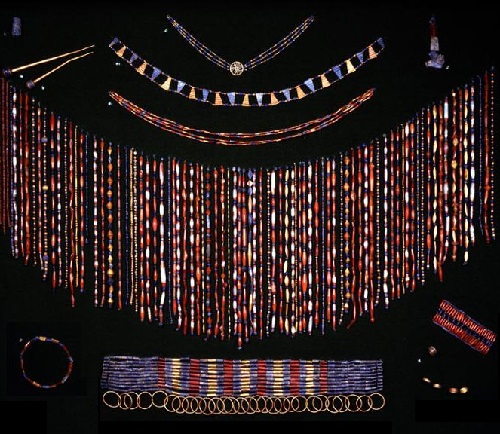
Bottom right – garter, lower right – a bracelet or cuff. Reconstructed decoration of Queen Puabi. Weight of jewelry is 14 pounds (about 6.5 kg). Museum of the University of Pennsylvania
However, Puabi was buried in an entourage of 26 people. The guards, maids, musicians, ladies and all the funeral procession with oxen, grooms and coachmen. She was found strewn with jewels – gold, silver, lapis lazuli, cornelian, agate and chalcedony beads with large gold earrings and headdress of gold flowers inlaid with Indian carnelian and Afghan lapis lazuli.
The amount of grave goods found in Puabi’s tomb was staggering: an abundance of silver, lapis lazuli, and golden rings and bracelets, a magnificent golden headdress made of golden leaves, rings, and plates; a superb lyre, complete with the golden and lapis-lazuli encrusted bearded bulls head; a profusion of gold tableware; golden, carnelian, and cylindrical beads for extravagant necklaces and belts; a chariot adorned with lioness’ heads in silver. When Puabi was found, on her fingers were 10 rings.
In the tomb of Puabi were mainly items made of lapis lazuli, combined with gold. Lapis lazuli – a stone that has not been mined in Sumer, it could be brought only from one place – the famous to this day Badakhshan deposit in Afghanistan. Now this is one of the poorest places in the world with the highest maternal mortality.
Noteworthy, a large number of carnelian beads. In one version, lapis lazuli was regarded as a male stone in Mesopotamia, and carnelian – female. In the suit of the priestess, the ancient female deity certainly hidden sacred meaning and a lot of symbols, not fully solved. The myths and rituals of the Sumerians have much in common with the Egyptian. The roots of these myths go back to more ancient times. Judging by the richness of the burial, the role of a female deity was in great authority, as is known, the position of women in Sumerian society was equal. Preserved cuneiform tablets that contain something like a proposal to ban women from having more than one husband.
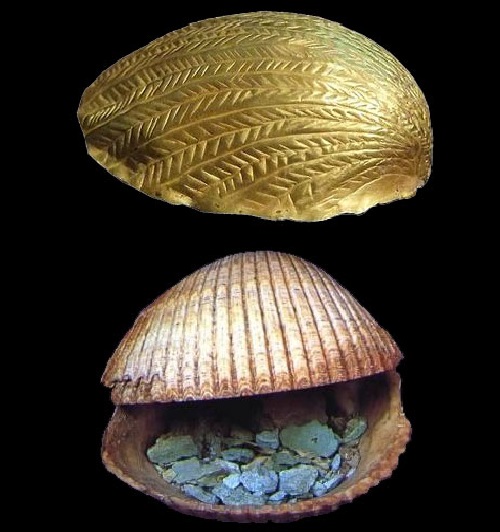
Golden Shell for eye-shadows. It was found with the remains of pigment. These shells were with many women buried together with Puabi. The most common was green pigment, used as eye shadow

3 individual cylinder seals belonged to Puabi – a very important finding, because they have brought her name to our time
The first impression shows a banquet – the servants are depicted smaller than the royals. Name Puabi in the upper left corner, the other alleged signs mean “Lady” or “queen”. Feast on the second print image includes men and women. They drink beer through a long straw to avoid contact with the mouth foam or muddy sediment (vessels and long straws also found in the tomb). In the third printing banquet scene again, but with the participation of some women. On the bottom right shown a woman playing a harp.
This image particularly well illustrates the dual nature of Inanna. On the one hand, Inanna is shown here as the goddess of love, underscoring her position with flirty but powerfully exposed leg, “trampling” lion. On the other hand the lion, arms behind her indicate that she is also the goddess of war. 8-Point Star (Venus) – another symbol of Inanna (flipped on the print).
Queen Puabi jewellery
Although Inanna was the goddess of love – she is not associated with such concepts as marriage and childbearing. She represents the carnal desire and always gets what she wants. Also, she symbolizes the violence and uncontrolled human passions. And therefore the deadly fury of battle and destruction of war. In peacetime, she is not so terrible, but, as can be seen from the myths that have survived in the book (the first written language) – Inanna pretty treacherous, vengeful and vindictive. But at the same time self-confident, proud and beautiful. The Sumerians were thankful to the goddess Inanna for the eternal life after death and rebirth.
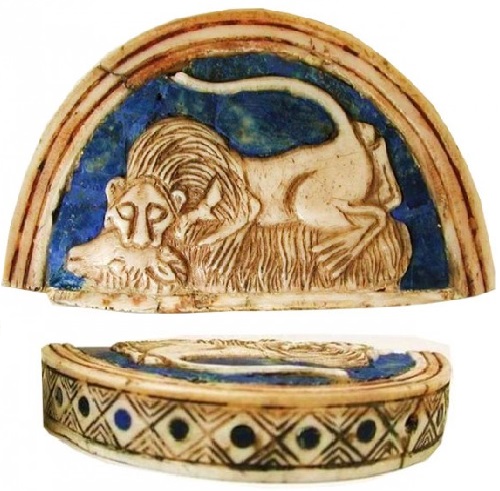
Beautician of Puabi made of lapis lazuli. On the cover depicted a lion, the sacred animal of Inanna, attacking sheep

Near Puabi were found three gold pins with carnelian. They attached cylinder seals (made of lapis lazuli) to her clothing
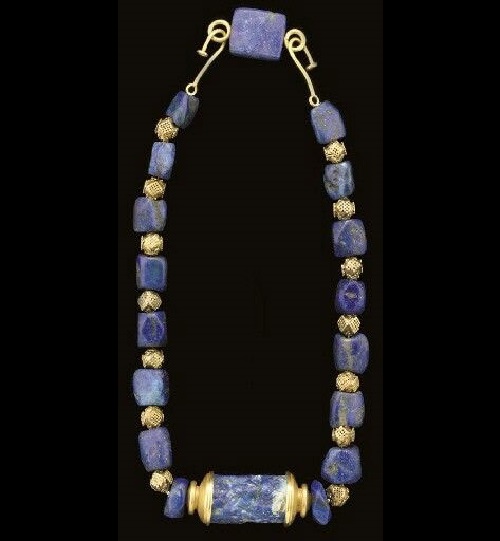
This necklace made of lapis lazuli and gold was found from other excavations, it also very clearly demonstrates the features of the ancient Sumerian blue and gold ornaments
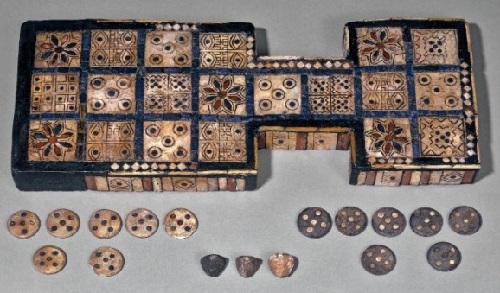
In the tomb of Puabi was found the oldest board game. It is considered the prototype of a game of backgammon
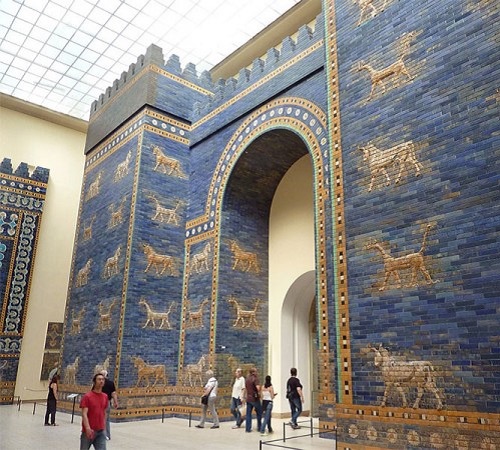
Ishtar Gate from Babylon, from a later historical period (VII century BC). The gates are now kept in the Museum in Berlin
Apparently, the main colors of the Sumerian-Babylonian goddess of love and war were blue and gold. This combination of colors really looks divine. Perhaps the blue lapis lazuli stones have been the hallmark of the Sumerian priestesses of Inanna or nobility. In the end, the stone was brought from far away, and it was certainly expensive. Interestingly, lapis lazuli jewelry was found in the tombs of Egyptian Pharaohs, in Scythian burial mounds, and even among the findings of Schliemann in ancient Troy.
source world-jewellery.livejournal.com
